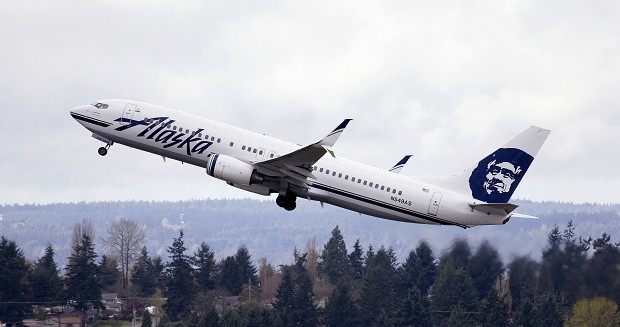
In this photo taken March 24, 2015, an Alaska Airlines jet takes off at Seattle-Tacoma International Airport in SeaTac, Wash. A UN panel on Feb. 8, 2016, proposed long-sought greenhouse gas emissions standards for airliners and cargo planes beginning in 2020 for new aircraft designs and three years later for designs already in production. The International Civil Aviation Organization said the agreement reached by 170 international experts sets a cutoff date of 2028 for the manufacture of planes that don’t comply with the standards. AP FILE PHOTO
WASHINGTON — A UN panel on Monday proposed long-sought greenhouse gas emissions standards for airliners and cargo planes, drawing praise from the White House and criticism from environmentalists who said they would be too weak to actually slow global warming.
The International Civil Aviation Organization said the agreement reached by the agency’s environmental panel requires that new aircraft designs meet the standards beginning in 2020, and that designs already in production comply by 2023. There is also a cutoff date of 2028 for the manufacture of planes that don’t comply with the standards. The standard must still be adopted by the agency’s 36-nation governing council, but substantive changes aren’t expected.
The standards would be the first ever to impose binding energy efficiency and carbon dioxide reduction targets for the aviation sector. When fully implemented, the standards are expected to reduce carbon emissions by more than 650 million tons between 2020 and 2040, equivalent to removing over 140 million cars from the road for a year, according to the White House.
The standards would require an average 4 percent reduction in fuel consumption during the cruise phase of flight starting in 2028 when compared with planes delivered in 2015. However, planes burn the most fuel during takeoffs and landings, while cruising at high altitudes is already the most fuel-efficient period.
The agreement is the first of two important opportunities this year to reduce carbon emissions from aviation. The second opportunity will come later this year when ICAO tries to reach an agreement on a “market-based approach” that would use economic incentives to further reduce aviation carbon emissions.
READ: 40-country survey: Majority support for cutting emissions
“Today’s agreement is an important signal that the international community is well-positioned to rise to the challenge of implementing a global market-based approach to reduce aviation emissions,” the White House said in a statement.
The standards announced Monday don’t set the bar high enough, said Dan Rutherford, aviation direction of the International Council on Clean Transportation, since they require reductions of only about a third of what is expected to be technically possible with the more fuel-efficient planes that will be in production when the standard takes effect.
The newest Boeing and Airbus designs already meet the proposed efficiency standards, due to demands for fuel savings from the airlines, environmentalists said. In the meantime, the manufacturers get to continue selling older, less efficient designs for years to come. Airliners in use now are exempt from the new standards altogether, meaning even dirtier planes can continue to fly.
But ICAO council president Olumuyiwa Benard Aliu said the agency’s goal “is ultimately to ensure that when the next generation of aircraft types enters service, there will be guaranteed reductions in international carbon emissions.”
Environmentalists also complained that ICAO has been working on international standards for 18 years and is now proposing to give aircraft manufacturers another dozen years to comply.
“These dangerously weak recommendations put the Obama administration under enormous pressure” to take greater action, said Vera Pardee, a Center for Biological Diversity attorney who has sued the US government over aviation emissions.
Last June, the Obama administration proposed regulating aircraft emissions, saying they are a threat to human health because they contain pollutants that help cause global warming. But a final US decision on adoption of international standards is likely to be left to the next presidential administration. EPA officials said at the time that the earliest the agency is likely to propose adoption of ICAO standards would be in 2017.
Boeing is the United States’ largest exporter as measured in dollar value. The company vies with Airbus for the title of world’s largest aircraft maker.
Aviation accounts for about 5 percent of global greenhouse emissions, according to environmentalists. ICAO says it’s actually less than 2 percent.
READ: PH Senate ratifies amendments to Kyoto pact on greenhouse gas cuts
But that share is expected to grow as aviation grows. “We also recognize that the projected doubling of global passengers and flights by 2030 must be managed responsibly and sustainably,” said Aliu.
The action comes two months after UN climate negotiators in Paris left the aviation industry out of their landmark global agreement to combat global warming.
The proposed standard covers the full range of sizes and types of aircraft used in international aviation today, but reserves the strictest standards for planes weighing over 60 tons, ICAO said. The larger planes are responsible for about 90 percent of international aviation emissions.